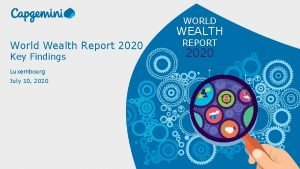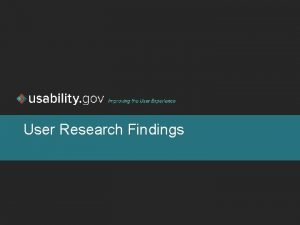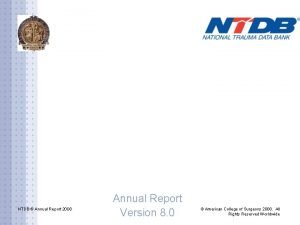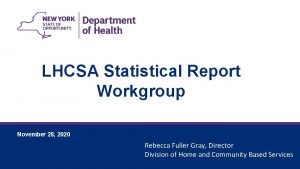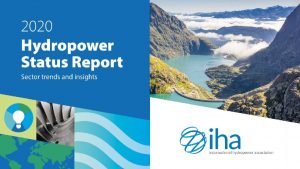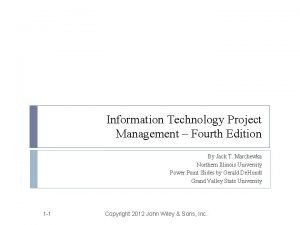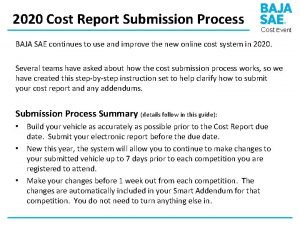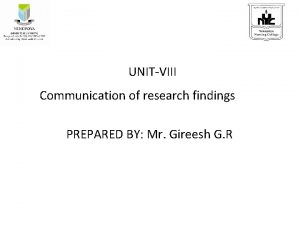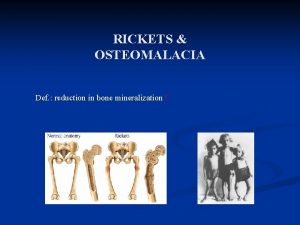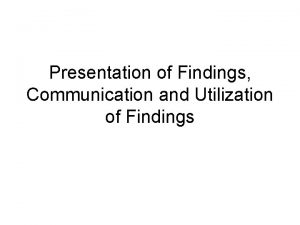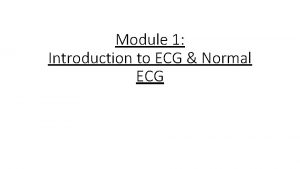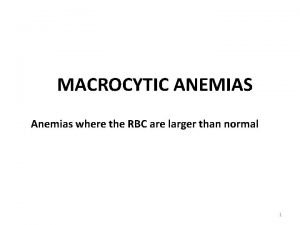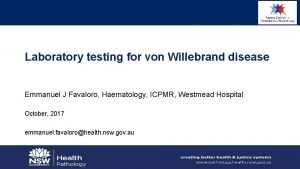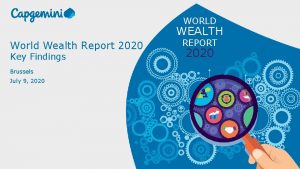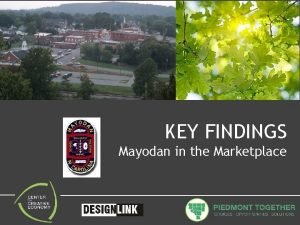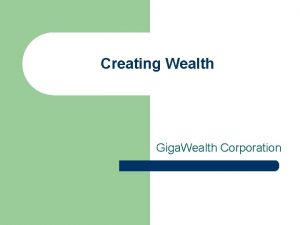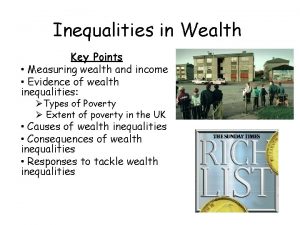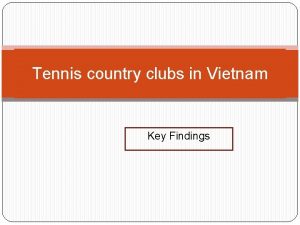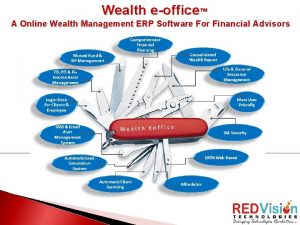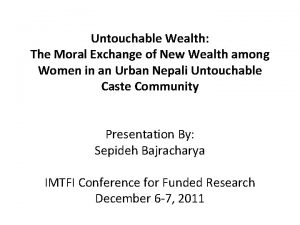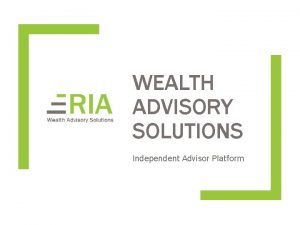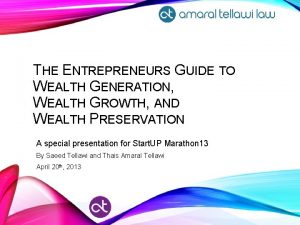WORLD WEALTH World Wealth Report 2020 Key Findings






























- Slides: 30

WORLD WEALTH World Wealth Report 2020 Key Findings Luxembourg July 10, 2020 REPORT 2020

WELCOME Robert van der Eijk Managing Director Capgemini Invent Be. Lux Executive Vice Presedent robert. van. der. eijk@capgemini. com +32 475 54 44 80 World Wealth Report 2020 | July 9, 2020 © Capgemini 2020. All rights reserved | 2

A complete range of businesses We are 270, 000 people, passionate about helping our clients solve their most complex business and technology challenges, and we deliver transformational outcomes at scale. We are driven by the conviction that the business value of technology comes from and through people. Capgemini Invent is the Group’s digital innovation, consulting and transformation brand. They bring to life what’s next for their clients by combining strategy, technology, data science and creative design. Sogeti works closely with its clients at a local level and mobilizes expert teams that create custom solutions from existing and emerging technologies to deliver viable outcomes at speed. Altran is Capgemini Group's world leading provider of Engineering and R&D services, with a portfolio of high-profile clients, extensive sector expertise and in-depth understanding of industrial business processes and operational technologies.

Leading insights on global wealth management industry 24 th edition “Maximize impact during uncertainty through sharp focus” 10+ quotes from top banks’ executives Solutions • Digital Wealth Advisor platform • Innovation as a service with scaleups 20+ 70+ wealth management executives participated through surveys and interviews World Wealth Report 2020 | July 9, 2020 markets covered across Americas, EU, APAC and Middle East © Capgemini 2020. All rights reserved | 4

Methodology and Key Definitions Methodology Market Sizing High Net-Worth Individual Behavior Spotlight Country statistics feeding into the proprietary market sizing model Survey of more than 2, 500 high net-worth individuals across 21 countries Survey and interviews of more than 70 executives across more than 10 countries Key Definitions Terms Definition HNWIs High net-worth individuals with investable assets of USD 1 million or more, excluding primary residence, collectibles, consumables, and consumer durables Mass Affluent Wealth band with investable assets between USD 100, 000 and USD 1 million Millionaires Next Door Wealth band of HNWIs with investable assets between USD 1 and 5 million Mid-Tier Millionaires Wealth band of HNWIs with investable assets between USD 5 and 30 million Ultra-HNWIs Wealth band of HNWIs with investable assets of USD 30 million or more World Wealth Report 2020 | July 9, 2020 © Capgemini 2020. All rights reserved | 5

Unusual times call for new ways of working Maximize impact during uncertainty through sharp focus Driven by real-time connectivity and economic ambiguity, unusual financial trends are emerging and the strategic case for sustainable investment is advancing World Wealth Report 2020 | July 9, 2020 Hyper-personalization will empower wealth management firms to address HNWI expectations and capture key transition points, at risk from Big. Tech encroachment Open platform is the way forward for wealth management firms to optimize operating model and cost structures COVID-19 will reshape banking! Co. VID-19 forces banks to accelerate digital transformation to navigate through uncertain times © Capgemini 2020. All rights reserved | 6

Unusual times call for new ways of working Maximize impact during uncertainty through sharp focus Driven by real-time connectivity and economic ambiguity, unusual financial trends are emerging and the strategic case for sustainable investment is advancing World Wealth Report 2020 | July 9, 2020 Hyper-personalization will empower wealth management firms to address HNWI expectations and capture key transition points, at risk from Big. Tech encroachment Open platform is the way forward for wealth management firms to optimize operating model and cost structures COVID-19 will reshape banking! Co. VID-19 forces banks to accelerate digital transformation to navigate through uncertain times © Capgemini 2020. All rights reserved | 7

The post Co. VID-19 impacts all aspects Impact to Margins & Fee Income Potential hit to margins - Banks will either grow revenue or reduce operating costs World Wealth Report 2020 | July 9, 2020 Customers Shift In Assets Investment shifts towards ‘safe havens’ and reshuffling of portfolios Manage Customer Trust & Concerns to build Advocacy Data and Processing Sense & Respond Protecting customer trust and amplifying advocacy Requirement for agility (Operations, Data, Processes Communications & Regulatory programs) given the speed at which things are changing © Capgemini 2020. All rights reserved | 8

Unprecedented times act as catalyst for change Customer behavior is evolving fast Traditional players have been slow to react to the evolving digital demands of the customer Uncertain times are accelerating this change During uncertain times, digital agility helps banks respond quickly to customer needs and requests $ Before COVID-19 Only 49% of customers used 50% of customers said that their primary banks are well connected to other platforms During & after COVID-19 57% internet banking 47% of customers used mobile apps 55% 15% of customers interacted with banks 21% for banking via chatbots World Wealth Report 2020 | July 9, 2020 of consumers would prefer internet banking of customers would prefer mobile apps for banking 30% Up to of customers are willing to shift to Big. Techs/ Fin. Techs because of unsatisfactory experiences with their primary bank of customers would prefer chatbots and automated voice help when interacting with banks © Capgemini 2020. All rights reserved | 9

REDUCE COSTS WHILE REENGAGING A POSITIVE PEOPLE DYNAMIC FRUGAL We believe Responsive Working Paradigm should be designed to benefit Corporates, Employees and Society AGILE / RESILIENT REINVENT A MORE FLEXIBLE WORKING PARADIGM BUT PERSERVE SKILLS AND KNOWHOW PEOPLE CENTRIC REDEFINE THE EMPLOYER / EMPLOYEE SOCIAL CONTRACT WITHOUT LOOSING DNA SUSTAINABLE LOWER THE CARBON FOOTPRINT OF WORK RELATED SYSTEM World Wealth Report 2020 | July 9, 2020 © Capgemini 2020. All rights reserved | 10

Real-time information and complex global interdependencies spark unusual market trends Driven by real-time connectivity and economic ambiguity, unusual financial trends are emerging and the strategic case for sustainable investment is advancing World Wealth Report 2020 | July 9, 2020 Hyper-personalization will empower wealth management firms to address HNWI expectations and capture key transition points, at risk from Big. Tech encroachment Open platform is the way forward for wealth management firms to optimize operating model and cost structures COVID-19 will reshape banking! Co. VID-19 forces banks to accelerate digital transformation to navigate through uncertain times © Capgemini 2020. All rights reserved | 11

Stock markets shine in a slowing economy to drive up HNWI population, 2012– 2019 (by region) CAGR 2012– 2018: 7. 1% % change 2018 – 19: 19. 6 HNWI population (millions) 20 15 13. 7 12. 0 0. 1 0. 5 10 5 0. 1 0. 5 0. 6 3. 8 14. 7 0. 2 0. 5 0. 6 4. 0 15. 4 0. 2 0. 5 0. 6 4. 2 16. 5 0. 2 0. 6 3. 7 4. 8 3. 7 4. 3 4. 7 5. 1 2012 2013 2014 2015 18. 1 18. 0 0. 2 0. 6 0. 7 0. 2 0. 6 0. 8 5. 2 4. 8 Africa Latin America Middle East 6. 1% 2. 7% 9. 3% Europe 8. 7% Strong growth 10. 9% Growth champion 4. 8 4. 5 3. 4 4. 3 2019 global GDP growth decelerated by 0. 6 PP to 2. 3% (from 2. 9% in 2018) Annual growth 2018– 2019: 8. 8% 5. 2 5. 7 6. 3 5. 5 6. 2 6. 1 6. 5 2016 2017 2018 2019 North America Asia-Pacific For 1 st time since 2012, not leading the growth 7. 6% 0 Hyper-connectivity and speed of communications are changing the rules of the game. Note: Chart numbers and quoted percentages may not add up due to rounding. Source: Capgemini Financial Services Analysis, 2020; https: //www. world-exchanges. org/news/articles/world-federation-exchanges-releases-first-quarter-2020 -full-year-2019 -market-highlights. World Wealth Report 2020 | July 9, 2020 © Capgemini 2020. All rights reserved | 12

Bucking a decade-old trend, developed markets lead global wealth growth HNWI financial wealth, 2012– 2019 (by region) CAGR 2012– 2018: 6. 7% Annual growth 2018– 2019: 8. 6% 70. 2 HNWI financial wealth (USD trillions) 75 56. 4 52. 6 50 46. 2 1. 3 1. 8 1. 3 2. 1 7. 7 7. 5 12. 4 1. 4 2. 3 7. 7 13. 0 58. 7 1. 4 2. 3 12. 7 14. 9 16. 2 1. 5 2. 4 13. 6 16. 6 8. 7 68. 1 1. 6 2. 6 15. 9 1. 7 2. 9 8. 8 Africa Middle East Latin America 8. 4 8. 0 7. 4 10. 9 25 63. 5 1. 7 2. 5 74. 0 16. 7 15. 4 Europe % change 2018 -19 6. 5% 10. 2% 4. 4% 8. 8% Strong growth 14. 7 19. 6 21. 6 20. 6 22. 2 2017 2018 2019 18. 0 12. 0 14. 2 15. 8 17. 4 18. 8 2012 2013 2014 2015 2016 21. 7 19. 8 North America 11. 0% Growth champion Asia-Pacific For 1 st time since 2012, not leading the growth 7. 9% 0 Will the financial markets prove more resilient than the economy in 2020 as well? Note: Chart numbers and quoted percentages may not add up due to rounding. Source: Capgemini Financial Services Analysis, 2020; https: //www. world-exchanges. org/news/articles/world-federation-exchanges-releases-first-quarter-2020 -full-year-2019 -market-highlights. World Wealth Report 2020 | July 9, 2020 © Capgemini 2020. All rights reserved | 13

COVID-19 makes a huge dent but markets slowly revive Early analysis of COVID-19 impact on financial markets, Jan–Jun 2020 In Q 1 2020, the impact of COVID-19 wiped out over USD 18 trillion from markets globally over the course of February and March 2020, before recovering slightly in April. Global Stock Market Chart (29 th Jan – 26 th Jun 2020) Current Peak COVID Pre-COVID Estimated decline of 6– 8% in the global HNWI wealth till the end of April 2020 (vs the end of 2019)* Estimated decline of 6– 8% in the global wealth till the end of April 2020 (vs the end of 2019) 29 -Jan 8 -Feb FTSE 18 -Feb 28 -Feb Nikkei 225 9 -Mar 19 -Mar 29 -Mar 8 -Apr Shanghai Stock Exchange 18 -Apr 28 -Apr Hang Seng 8 -May 18 -May 28 -May Nasdaq 7 -Jun *calculated based on EIU data for national statistics and asset returns for various asset classes from publicly available sources 17 -Jun CAC 40 Future-proof the business to prepare for volatility. Note: The stock index chart represents percentage change from 29 Jan 2020. Source: Capgemini Financial Services Analysis, 2020; Text Line Searches. World Wealth Report 2020 | July 9, 2020 © Capgemini 2020. All rights reserved | 14

COUNTRY SNAPSHOTS – LUXEMBOURG Luxembourg Number of HNWIs for Luxembourg (‘ 000), 2018– 2019 # of HNWIs (‘ 000) 60 40. 0 Change (2018– 2019) 40. 2 40 Drivers of Wealth (+) § Real estate prices increased by 14. 6% in 2019 0. 4% 20 Inhibitors of Wealth (-) 0 2018 § Real GDP grew by 2. 3% in 2019, lower than 3. 1% growth in 2018 § Market Capitalization declined by 10. 6% in 2019 § National savings as a percentage of GDP declined marginally to 20. 5% in 2019 HNWI Financial Wealth (US$ billion) for Luxembourg, 2018– 2019 HNWI Financial Wealth (US$ bn) 150 116. 1 116. 8 Change (2018– 2019) 0. 6% 100 COVID-19 IMPACT We have estimated a decline of 6– 8% in the global HNWI wealth till the end of April 2020 (vs the end of 2019)* 50 *calculated based on EIU data for national statistics and asset returns for various asset classes from publicly available sources 0 2018 2019 Note: HNWI numbers have been rounded up to one decimal place for representation while the change is calculated based on complete numbers Source: Capgemini Financial Services Analysis, 2020; Capgemini Lorenz curve methodology; Economist Intelligence Unit, May 2020; Global Property Guide House Price Index, March 2020 WWR 2020_Country Decks World Wealth Report 2020 | July 9, 2020 For your use only, do not distribute internally/externally © Capgemini 2020. All rights reserved | 15 15

COUNTRY SNAPSHOTS – LUXEMBOURG Luxembourg – 2019 Economic Review Key Macroeconomic Drivers and Inhibitors of HNWI Wealth Factor 2019 Performance 2019 Drivers and Inhibitors GDP Growth § Real GDP Growth: • 2. 3% in 2019 • 3. 1% in 2018 § Real GDP grew 2. 3% in 2019, lower than the 3. 1% growth in 2018. § The economic growth in 2019 was mainly driven by private consumption and investments (which rebounded after a sharp drop in 2017). § National Savings as a Percentage of GDP: • 20. 5% in 2019 • 21. 6% in 2018 § National savings as a percentage of GDP stood at 20. 5% in 2019: • Nominal private consumption stood at US$21. 3 billion, representing an increase of 0. 8% in 2019. • Nominal Government consumption stood at US$12 billion, representing a rise of 1. 1% in 2019. Market Capitalization Change § Market Capitalization Change: • (10. 6%) in 2019 • (27. 9%) in 2018 § Market capitalization continued its downward trend with a decline of 10. 6% in 2019, after a decline of 27. 9% in 2018. § The Luxembourg Stock Exchange’s emphasis on sustainable investing will prove more relevant in a post-COVID environment. Real Estate § Real Estatea price change: • 14. 6%b in 2019 • 0. 9% in 2018 § The real estate market grew by a massive 14. 6% in 2019, compared to a growth rate of 0. 9% in 2018. § The high growth in the real estate prices are a direct consequence of the imbalance between the demand supply for housing in the country. Savings a Average Selling price of Apartments - Luxembourg b Y-o-Y change from Q 3 2018 to Q 3 2019 Note: National savings as a percentage of GDP = Gross national savings rate (%) - Aggregate national savings by the public and private sector as a percentage of nominal GDP Source: Capgemini Financial Services Analysis, 2020; Economist Intelligence Unit, May 2020; Global Property Guide House Price Index, March 2020; Nordea Trade; Spuerkeess WWR 2020_Country Decks World Wealth Report 2020 | July 9, 2020 For your use only, do not distribute internally/externally © Capgemini 2020. All rights reserved | 16 16

COUNTRY SNAPSHOTS – LUXEMBOURG Luxembourg – 2019 Economic Review Other Key Drivers and Inhibitors of HNWI Wealth Factor 2019 Drivers and Inhibitors Monetary Policy § The ECB is committed to keeping inflation below, but close to, 2% over the medium term. § As a result of low inflation, the ECB kept the key interest rates unchanged with refinancing rate at 0. 0% and lending rate at 0. 25% while deposit rates were reduced by 10 basis points to (0. 5%) in 2019 over the previous year. § As a part of the Governing Council’s asset purchase program (APP), net purchases were restarted on November 1 at a monthly pace of 20 billion euros. § The Governing Council intends to reinvest the proceeds from maturing securities under APP for an extended period of time past the dates when it starts raising the key ECB interest rates. § Inflation rate was estimated at 1. 9% in 2019, slightly lower when compared to 2% in 2018. Fiscal Policy § The public debt level is one of the lowest in the Eurozone at 21. 3% in 2019 and was projected to keep declining in the coming years (projections made before COVID impact). § The country maintained a healthy budgetary position, with an estimated 2019 surplus of 0. 9% of GDP. Other Factors § The unemployment rate stood at 5. 4% in 2019. § The main challenges remain the increasing future costs of population ageing and the financial standardization measures that are of concern in the economic circles. Source: Capgemini Financial Services Analysis, 2020; European Central Bank, December 2019; Nordea Trade WWR 2020_Country Decks World Wealth Report 2020 | July 9, 2020 For your use only, do not distribute internally/externally © Capgemini 2020. All rights reserved | 17 17

Hyper-personalize to safeguard traditional as well as new wealth amid volatility Driven by real-time connectivity and economic ambiguity, unusual financial trends are emerging and the strategic case for sustainable investment is advancing World Wealth Report 2020 | July 9, 2020 Hyper-personalization will empower wealth management firms to address HNWI expectations and capture key transition points, at risk from Big. Tech encroachment Open platform is the way forward for wealth management firms to optimize operating model and cost structures COVID-19 will reshape banking! Co. VID-19 forces banks to accelerate digital transformation to navigate through uncertain times © Capgemini 2020. All rights reserved | 18

Equity regains the top spot in 2019 Asset allocation, Q 1 2018, Q 1 2019, Jan–Feb 2020 a (global) 2017 2018 2019 Total wealth (US$ trillion) 70. 2 68. 1 74. 0 Wealth growth (%) 10. 6% (3. 0%) 8. 6% 9. 4% 13. 0% 12. 9% 15. 8% 14. 6% 17. 1% 100% Alternative Investments Real Estate Fixed Income Cash & Cash Equivalents Percentage of Assets (%) 16. 8% 75% 15. 8% Wealth. Techs such as Wealthfront and Robinhood are increasingly focusing on cash management solutions, ready for a potentially greater allocation to cash 50% 27. 2% 27. 9% 25. 2% 25% Equity 30. 9% 25. 7% 30. 1% With 2020 being a volatile year, what will asset allocation look like in Q 1 2021? 0% Q 1 2018 Q 1 2019 Q 1 2020 Q 1 2021 With the current crisis and volatility, are there more asset allocation adjustments on the 2021 horizon? a. Source: The chart reflects HNWIs’ asset allocation at the time of conducting the survey (between January–February 2020) and does not reflect COVID-19 impact. Capgemini Financial Services Analysis, 2020; Capgemini Global HNWI Insights Survey 2020. World Wealth Report 2020 | July 9, 2020 © Capgemini 2020. All rights reserved | 19

Breakdown of HNWI financial assets, Jan-Feb 2020 (global and regions) 100% 12. 9% 15. 4% 19. 0% 15. 3% Alternative Investments 11. 0% 16. 5% 18. 9% 75% 10. 6% 13. 8% 14. 6% Percentage of assets 10. 1% 16. 2% 19. 0% Real Estate 17. 5% 17. 1% 16. 2% 18. 8% 18. 3% 50% Fixed Income 22. 1% 29. 0% 25. 2% 27. 5% 24. 1% 21. 9% Cash & Cash Equivalents 25% 38. 8% 30. 1% 30. 8% 22. 7% 24. 5% 21. 8% Equity 0% Global Asia-Pacific excl. Japan Latin America North America Europe a. Includes structured products, hedge funds, derivatives, foreign currency, commodities, private equity. b. Excludes primary residence. Note: Question asked: “What percentage does each of these asset classes approximately represent in your CURRENT financial portfolio? ” Chart numbers may not add up to 100% due to rounding. Source: Capgemini Financial Services Analysis, 2020; Capgemini Global HNW Insights Survey 2020. World Wealth Report 2020 | July 9, 2020 © Capgemini 2020. All rights reserved | 20

Fee structures are coming under greater scrutiny HNWIs’ concerns with fees and their preferred fee structures, Jan–Feb 2020 (global) HNWIs have high expectations on transparency and value delivered for fees. 33% were uncomfortable with fees charged in 2019. Fee Structure Based on investment performance Existing 26% Desired HNWIs likely to switch WM provider in next 12 months 35% 22% The top 3 concerns with fees: 47% Transparency of fees Top Reason: High Fees Based on overall service quality (not just investment performance) 11% 41% Fees relative to performance 15% 42% As a percentage of assets 24% 13% 39% Value delivered HNWIs increasingly want to move away from asset-based fee structure to a performance-based and service-based fee structure High fees is a concern for 49% of Millionaires Next Door Loyalty comes at the price of higher performance and value delivered for the fees charged. a. PP denotes the percentage point change between the values in 2019 and 2018. Source: Capgemini Financial Services Analysis, 2020; Capgemini Global HNWI Insights Survey 2020. World Wealth Report 2020 | July 9, 2020 © Capgemini 2020. All rights reserved | 21

Fee structures are coming under greater scrutiny HNWIs’ concerns with fees and their preferred fee structures Jan–Feb 2020 (global) Fee Structure Existing Based on investment performance 26% Desired Jan–Feb 2020 (Europe) Existing Desired 35% 30. 7% 28. 2% Based on overall service quality (not just investment performance) 11% As a percentage of assets 15% 24% 13% 10. 7% 20. 2% 15. 7% 13. 1% HNWIs increasingly want to move away from asset-based fee structure to a performance-based and service-based fee structure a. PP denotes the percentage point change between the values in 2019 and 2018. Source: Capgemini Financial Services Analysis, 2020; Capgemini Global HNWI Insights Survey 2020. World Wealth Report 2020 | July 9, 2020 © Capgemini 2020. All rights reserved | 22

Value-added services can positively influence client experience Value-added services, importance and willingness to pay, Jan–Feb 2020 (Europe) HNWIs (<40 yrs) Millionaires Next Door Ultra-HNWIs Most preferred value-added services for Ultra HNWIs under 40 Real estate investment advice 38% 55% 48% 80% Tax planning HNWIs (60+ yrs) Legal consultation Inheritance advice 35% % customers interested by value-added services 3% 59% 27% Services catering to investments of passiona % customers willing to pay for value-added services Focus for value-added services are the young HNWIs across wealth bands. a. Investments of passion include investments in art, wine, collectibles, luxury cars, yachts, etc. Note: The percentage of HNWIs willing to pay for the value-added services are calculated from among the HNWIs who said they will be positively influenced if their wealth management firm provides value-added services. Source: Capgemini Financial Services Analysis, 2020; Capgemini Global HNWI Insights Survey 2020. World Wealth Report 2020 | July 9, 2020 © Capgemini 2020. All rights reserved | 23

Sustainable investing gains prominence…. and more relevance than ever Rising interest in sustainable investing products, Jan–Feb 2020 (global) Sustainable investing is gaining momentum… Highest interest from Asia-Pacific (excl. Japan) and Latam at HNWIs plan to allocate Ø 41% of their portfolio to sustainable investing by 2020 Ø 46% of their portfolio to sustainable investing by 2021 54% 40% 27% of overall HNWIs are interested in sustainable investing products Ultra-HNWIs, v/s 17% millionaires next door 41% HNWIs <40 yrs, v/s 16% HNWIs >60 yrs Wealth management firms are ready to capture this growing demand Among the wealth management firm executives interviewed: 80% Offer sustainable investing (SI) options 12% Plan to provide SI options shortly 49% Ultra HNWIs < 40 yrs 8% Have no plans to provide SI options IN Q 1 2020, ESG-based portfolios outperformed broader indexes, with a surge in demand for sustainable investing post the pandemic outbreak. Note: Source: ESG stands for environmental, social, and governance factors Capgemini Financial Services Analysis, 2020; Capgemini Global HNWI Insights Survey 2020; https: //www. bloomberg. com/news/articles/2020 -03 -31/esg-stock-resilance-is-paving-the-way-for-a-surge-inpopularity; https: //www. bloomberg. com/news/articles/2020 -04 -02/virus-boosts-rich-asian-interest-in-sustainable-investing-trend. World Wealth Report 2020 | July 9, 2020 © Capgemini 2020. All rights reserved | 24

HNWIs see financial value in sustainable investing Primary reasons for interest in sustainable investing, Jan–Feb 2020 (global) Higher returns from sustainable investment products Sustainable investments seem sound, less speculative I now understand ESG funds better than previously Better sustainable investment offerings from firms I want to give back to society 39% 33% 29% 27% 26% Interestingly, a Capgemini survey conducted during the peak of the COVID-19 crisis in April 2020, revealed that there was an eight PP increase in the number of consumers who prefer to invest in assets with a societal impact, even if they get lesser returns (31% before COVID-19 outbreak vs 39% in the next 6 -9 months). Focus areas when choosing to invest in sustainable corporations HNWIs’ importance for focus area WM firms’ perception of HNWIs’ importance for focus area Effectively managing environmental risks 55% 43% Addressing climate change (reducing carbon footprint) 55% 45% Effective and ethical corporate governance systems 54% 63% Socially conscious business policies and practices 52% 55% WM firms need to align with their customers’ investment preferences to provide the right offerings. Source: Capgemini Financial Services Analysis, 2020; Capgemini Global HNWI Insights Survey 2020; Capgemini COVID-19 Consumer Survey of more than 11, 000 customers across 11 countries. World Wealth Report 2020 | July 9, 2020 © Capgemini 2020. All rights reserved | 25

Hyper-personalize through digital Technology-driven hyper-personalization Bespoke risk profiles Utilize behavioral sciences and sentiment analysis to identify individual clients’ risk profiles rather than just assigning one of pre-defined 5 or 6 risk profiles Personalized portfolio construction Data analytics and machine learning to be utilized on the trading history to create personalized portfolios Personalized advisory Personalized product recommendations Using AI-based analytics tools on client’s past data to make the most appropriate financial recommendations Portfolio aggregation Leveraging APIs to create a comprehensive view of the client Hyper-personalized offerings Charles Schwab’s “Project Bear” program uses artificial intelligence to study clients’ reaction to market performance and advise against poor investment decisions Personalized communications Using data analytics and multi-channel engagement to provide interactive and personalized reporting WM firms should act quickly to safeguard existing client base and capture future growth. Source: Capgemini Financial Services Analysis, 2020. World Wealth Report 2020 | July 9, 2020 © Capgemini 2020. All rights reserved | 26

Manage uncertainty through sharp focus on the critical 20% of the value chain Driven by real-time connectivity and economic ambiguity, unusual financial trends are emerging and the strategic case for sustainable investment is advancing World Wealth Report 2020 | July 9, 2020 Hyper-personalization will empower wealth management firms to address HNWI expectations and capture key transition points, at risk from Big. Tech encroachment Open platform is the way forward for wealth management firms to optimize operating model and cost structures COVID-19 will reshape banking! Co. VID-19 forces banks to accelerate digital transformation to navigate through uncertain times © Capgemini 2020. All rights reserved | 27

Danger – perfect storm is building up Disruptors to the wealth management industry, Mar–Apr 2020 (global) Impact of natural events such as pandemics Economy Competition 59% Changing client profiles and expectations The great wealth transfer and uncertainty regarding future customers Fee pressure due to zero trading commissions and increasing shift towards passive products Global economic slowdown 39% 35% 31% Wealth management industry disruptors 29% Changing market dynamics through increasing information transparency 29% 26% Impact of technology and change in business models Geo-political instability Expectations 26% Threat of new entrants such as Big. Tech firms Agile, adaptive, fast are no more just buzzwords – act now. Source: Capgemini Financial Services Analysis, 2020; WWR 2020 Executive Interviews, 2020. World Wealth Report 2020 | July 9, 2020 © Capgemini 2020. All rights reserved | 28

Wealth management Achilles’ heel: lack of personalized interactions Wealth management client journey analysis 1 Researching information about the firm 2 Product/ service or investment information search 3 Firm selection and onboarding 4 Receiving portfolio advice 5 Personalized updates about new products/ services 6 Receiving educational market information 61% 60% 63% 18 PP 17 PP 18 PP 48% 44% 42% Touchpoints with least client satisfaction % denotes HNWIs not satisfied with their firm’s service at the touchpoint Accessing portfolio information Executing transactions 7 Touchpoints most vulnerable to Big. Tech 8 9 General communication with wealth manager 10 Interactions Receiving with specific value-added experts in services the firm 11 64% 17 PP PP denotes how much higher is the percentage of HNWIs who rate Big. Techs as more likely to provide excellent service 64% 18 PP 43% Wow impact % denotes HNWIs for whom a good experience at the touchpoint will strongly improve overall firm perception Focus on a few information and value-added related areas, will help wealth firms deliver big. Source: Capgemini Financial Services Analysis, 2020. World Wealth Report 2020 | July 9, 2020 © Capgemini 2020. All rights reserved | 29

Thank You About Capgemini is a global leader in consulting, digital transformation, technology and engineering services. The Group is at the forefront of innovation to address the entire breadth of clients’ opportunities in the evolving world of cloud, digital and platforms. Building on its strong 50 -year+ heritage and deep industry-specific expertise, Capgemini enables organizations to realize their business ambitions through an array of services from strategy to operations. Capgemini is driven by the conviction that the business value of technology comes from and through people. Today, it is a multicultural company of 270, 000 team members in almost 50 countries. With Altran, the Group reported 2019 combined revenues of € 17 billion. People matter, results count. Learn more about us at www. capgemini. com This message contains information that may be privileged or confidential and is the property of the Capgemini Group. Copyright© 2020 Capgemini. All rights reserved.
 World wealth report
World wealth report Findings in research
Findings in research Key partners bmc example
Key partners bmc example Business model canvas tripadvisor
Business model canvas tripadvisor National trauma data bank annual report 2020
National trauma data bank annual report 2020 2020 lhcsa statistical report
2020 lhcsa statistical report Workday soc report
Workday soc report 2020 hydropower status report
2020 hydropower status report Standish group chaos report 2020
Standish group chaos report 2020 Baja sae cost report
Baja sae cost report Findings of qualitative research
Findings of qualitative research Tactile fremotus
Tactile fremotus Findings in research
Findings in research Example of qualitative vs quantitative
Example of qualitative vs quantitative Regio thorax posterior
Regio thorax posterior Osteoid definition
Osteoid definition Results and discussion in research example
Results and discussion in research example Pneumothorax auscultation findings
Pneumothorax auscultation findings Qualities behaviors and complexities
Qualities behaviors and complexities Recommendation and conclusion example
Recommendation and conclusion example Four quadrants abdomen
Four quadrants abdomen Acute interstitial nephritis urine findings
Acute interstitial nephritis urine findings Ers summary of findings
Ers summary of findings Svt no p waves
Svt no p waves Lesch nyhan syndrome
Lesch nyhan syndrome Schilling
Schilling Von willebrand labs
Von willebrand labs Semi-tabular presentation
Semi-tabular presentation Mouth assessment normal findings
Mouth assessment normal findings Attachment psychology a level
Attachment psychology a level Pansitopenia adalah
Pansitopenia adalah
